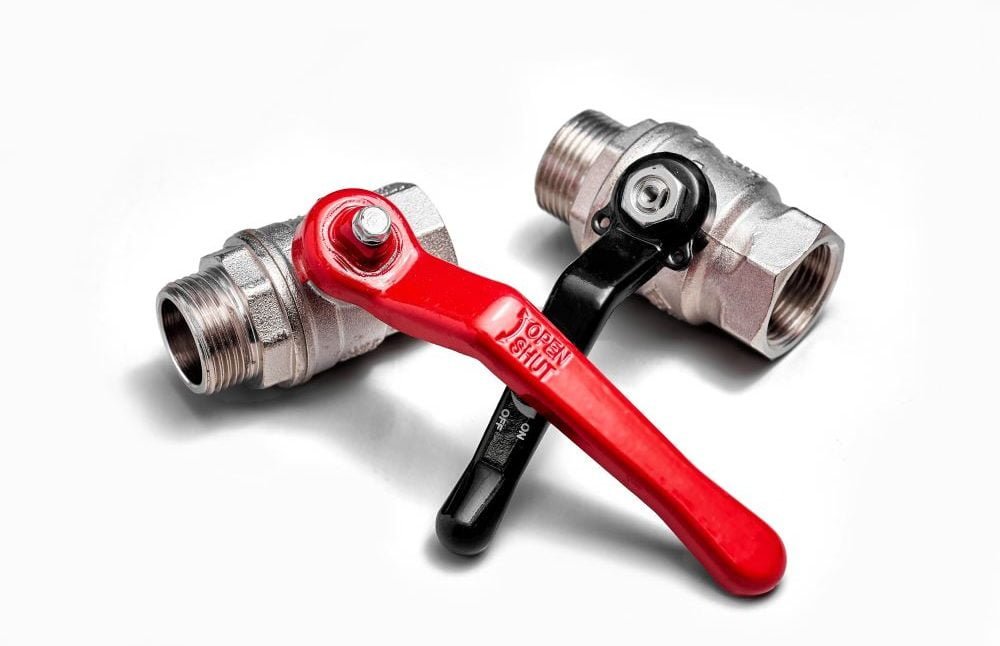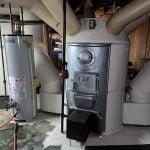Introduction
Gas Valve vs Water Valve: Gas and water valves are two common types of valves used for various applications such as plumbing, heating, and industrial processes. The primary function of valves is to control the flow of fluids or gases by either opening, closing, or partially obstructing the passage. Valves can be operated manually, automatically, or by sensors, and they come in different shapes, sizes, and designs depending on their purpose.
In this blog post, we will compare and contrast gas and water valves and explain their various types, features, and uses.
What Is a Gas Valve?
Gas valves are crucial in controlling gas flow in various systems regulating pressure, temperature, or volume. These valves can be found in multiple appliances, such as stoves, furnaces, heaters, boilers, generators, and pipelines. They are designed to handle different types of gases, including natural gas, propane, butane, or hydrogen, and can be operated manually, electrically, pneumatically, or hydraulically.
Don’t forget to read more about Types Of Furnace Ignitors.
Gas valves control and regulate gases, including liquid petroleum, oxygen, and natural gas. Typically, these valves are made of plastic, metal alloys, copper, or other materials suitable for pressure and media requirements. They come in various shapes, such as balls, butterflies, plugs, needles, and check valves. They are used in industrial, commercial, and residential applications for on/off, modulating, and controlling functions.

What Is a Water Valve?
A water valve is a device that manages how water flows in a system. Water valves serve various purposes, such as regulating water pressure, temperature, or volume or shutting off the water supply in case of a leak or burst pipe. Water valves are present in many appliances and equipment, like faucets, showers, toilets, washing machines, dishwashers, sprinklers, and water pipes. They are designed to handle different types of water, like potable water, wastewater, seawater, or steam. You can also read our guide about the Benefits of Geothermal Heat Pumps.
Water valves regulate and stop water flow and can be operated manually, electrically, pneumatically, or hydraulically. Each type has unique benefits, drawbacks, and applications. Most home plumbing systems use water valves to control pressurized water flow from a public or private supply. Valves can be designed for primary on-off control or regulating water flow volume.
Gas Valve vs Water Valve
| Feature | Gas Valve | Water Valve |
|---|---|---|
| Function | Controls gas flow | Controls water flow |
| Application | Used for gas pressure, temperature, volume, or safety | Used for water pressure, temperature, volume, or safety |
| Location | Found in gas appliances and equipment | Found in water appliances and equipment |
| Type of fluid | Handles different types of gas | Handles different types of water |
| Operation | Operated manually, electrically, pneumatically, or hydraulically | Operated manually, electrically, pneumatically, or hydraulically |
| Sensitivity and precision | More sensitive and precise than water valves | Less sensitive and accurate than gas valves |
| Durability and resistance | Less durable and resistant than water valves | more long-lasting and resistant than gas valves |
| Cost and complexity | More expensive and complex than water valves | Cheaper and more straightforward than water valves |
| Safety and environmental standards | Need to comply with strict standards and require more testing and maintenance | needs to comply with strict standards and require more testing and maintenance. |
| Types and SubTypes | Have different types and subtypes, such as plug, needle, metering, mixing, globe, pinch, gate, knife, drain, diverter, directional, butterfly, ball, or balancing valves | Have different types and subtypes, such as gate, globe, butterfly, check, or fixture shutdown valves |
What are the Major Types of Gas Valves
There are various gas valves, each with unique advantages and disadvantages. Below are the most significant and well-known types of gas valves:
Plug or stop-cock
These valves are designed to regulate gas flow using a cylindrical or conical plug. They are known for their simplicity and reliability and are easy to operate and maintain. However, they may have low flow rates and can lead to turbulence and erosion. These valves can support both on/off and throttling actions.
Needle valves
Needle valves use a tapered needle to regulate gas flow precisely. They are ideal for low-flow, high-pressure applications but can be challenging to seal due to high friction. Needle valves feature a narrow, tapering tip at the end of the stem.
Metering and mixing valves
Metering and mixing valves precisely measure and blend gas flow with other fluids or gases. They’re commonly used in applications like medical devices or combustion processes. However, these valves can be pricey and require frequent calibration and monitoring. In specialized applications, they’re crucial for accurately and consistently mixing gases and fluids.
Globe and pinch
These versatile and adaptable valves use a spherical or cylindrical body to control the gas flow. They can handle different gases and fluids and can be modified with other discs, seats, or stems. They have reasonable flow rates and sealing, but they have high-pressure drops and can be noisy and bulky.
Gate or knife valves
These robust and efficient valves use a flat or wedge-shaped gate to isolate or connect the gas flow. They are used for applications requiring full or no flow but have poor throttling and can be prone to leakage and corrosion. Gate valves are linear motion valves that shut off a stream by sliding a closure element into the flow.
Don’t forget to read more about SEER vs HSPF: Heat Pumps Efficiency Ratings
Drain valves
These essential and convenient valves allow the removal of gas or condensate from a system. They are used for applications that require draining or venting, but they have low flow rates and can be affected by dirt and debris. A drain valve is used to get rid of excess media.
Diverter valves
These flexible and functional valves divert gas flow to different outlets or directions. They are used for applications that require switching or bypassing, but they have low sealing and can cause backflow and pressure loss. Diverter valves reroute gas flow as well.
Directional valves
Directional and dynamic valves change the direction of gas flow in a system. They’re complex, need power and control, and direct flow through unavoidable passageways—valve types: block-and-bleed, blow-off, cartridge, check, and control.
Butterfly valves
These compact and economical valves use a rotating disc to regulate or stop gas flow. They are used for applications requiring moderate flow or pressure but have low sealing and can cause cavitation and vibration. They only allow flow in one direction.
Ball valves
Spherical ball valves are famous for gas flow control due to their reliability and speed. However, they have high torque and are sensitive to changes in temperature and pressure. While they are great for tight shutoffs, they are unsuitable for hygienic applications.
Balancing valves
These intelligent and sophisticated valves balance the flow of gas in a system. They are used for applications that require optimal and stable performance but have high costs and require sensors and actuators. They keep the temperature constant and compensate for pressure drops.
Different types of Water Valves
There are different types of water valves, each with unique pros and cons. Here are some of the most common kinds of water valves:
Gate valves
Gate valves, often used in water applications, control flow through a flat or wedge-shaped gate. While they excel in isolating or connecting water flow, they lack effective throttling, making them unsuitable for regulating flow volume. Operated by a twist lever or knob, gate valves work in fully open or closed states, offering reliability in shutting off water supply. Despite susceptibility to leakage and corrosion, they serve well as main or branch water supply line cutoffs, providing a simple ON or OFF functionality.
Globe valve
Though similar in design to globe valves, water globe valves are tailored explicitly for water applications. They utilize spherical or cylindrical bodies for water flow regulation, offering customization with various discs, seats, and stems. While ensuring reasonable flow rates and sealing, water globe valves exhibit drawbacks such as high-pressure drops, noise, and bulkiness. They are commonly used in outdoor and utility faucets, and globe valves prioritize flow control.
Butterfly valves
Butterfly valves for water applications use a rotating disc to regulate or stop water flow and are ideal for moderate flow or pressure. However, their lower sealing capabilities can cause cavitation and vibration. They look similar to ball valves from the outside and have lever-type handles to operate. It is essential to perform maintenance on the gasket within the butterfly valve over time to avoid wear and tear issues and ensure optimal performance.
Check Valve
Check valves to prevent backflow in various applications. They allow water to flow in one direction and come in different designs. Check valves have low flow rates and can cause noise and water hammer. Unlike most valves, they don’t have a control handle, and their primary function is to prevent water flow in the opposite direction. Stop-checking valves are more effective as they can stop all water flow in both directions.
Fixture shutdown valves
These handy and practical valves isolate the water supply to a specific fixture or appliance. They are used for applications that require maintenance or repair, such as sinks, toilets, or washing machines, but they have low durability and can be affected by wear and tear.
what is a redundant gas valve?
A redundant gas valve is a safety feature in gas-powered appliances that control fuel flow to the burner or heating element. It has multiple valves to reduce gas leaks. If one valve fails, the other maintains control, ensuring safe and efficient operation. A redundant gas valve has two or more valves in series, making it suitable for highly reliable and protected applications. It can improve the system’s efficiency and safety and increase cost and complexity.
What causes gas valve failure?
Here are some Common reasons for gas valve failure:





